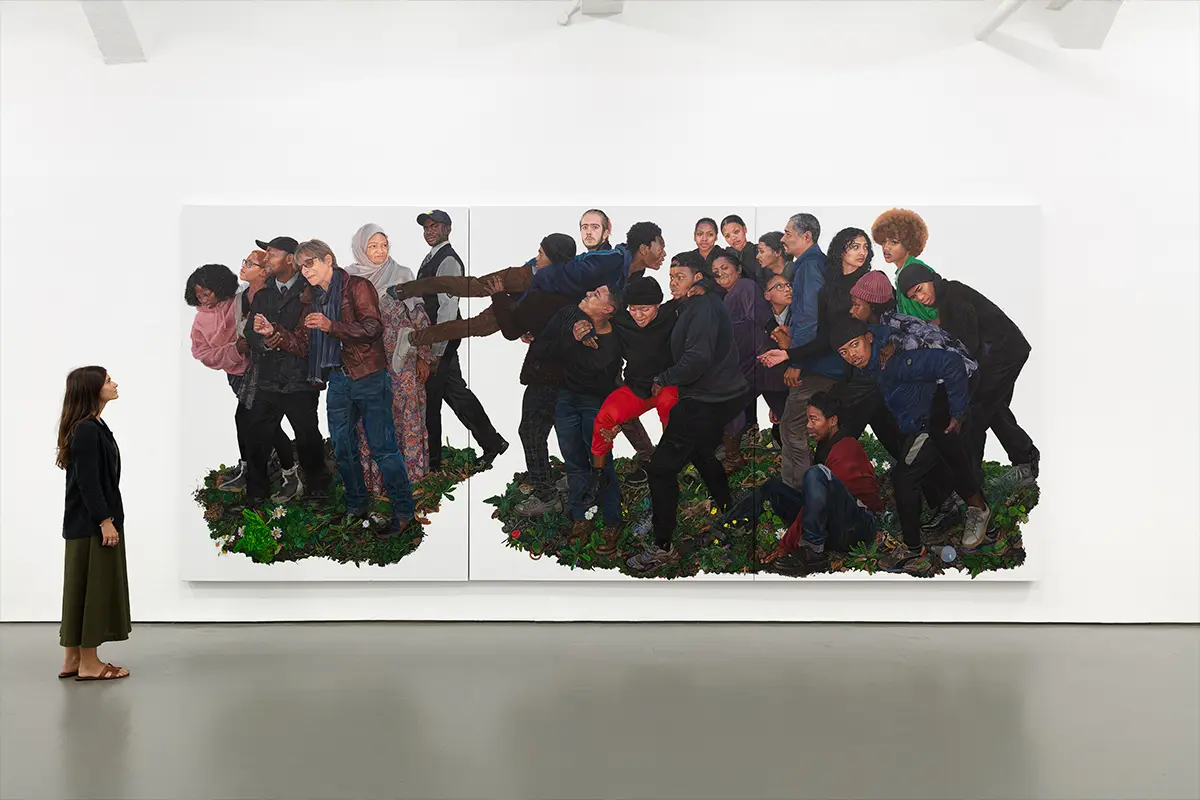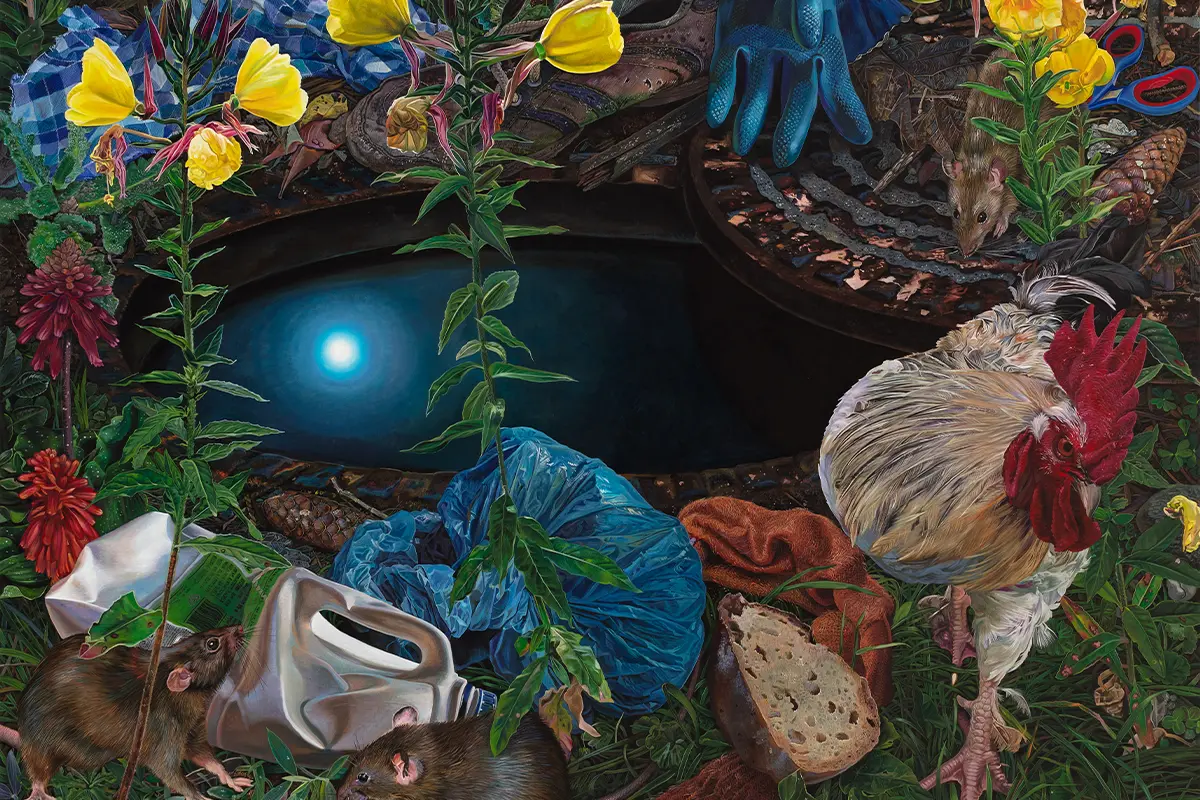Discordant objects amongst natural landscapes, nude portraits of herself, her friends and family, Deborah Poynton’s practice is about creating the illusion of reality, applying layers of oil painting
Deborah Poynton – painter of the hyper-realistic
Best known for her hyper-realistic and detailed paintings, Deborah Poynton is a South African whose work explores the act of perception. Placing discordant objects amongst natural landscapes, painting nude portraits of herself, her friends and family, Deborah Poynton’s practice is about creating the illusion of reality, applying layers of oil painting. Regarding the meaning of her art pieces, even if she wishes to let them be open to interpretation, Poyton remains assured about the message she’s conveying. «As a painter, I’m reflecting the ridiculousness of the act of painting, which is inevitably a failed attempt at control of reality. I’m reflecting my own filter onto the canvas».
Deborah Poynton – South Africa, the UK, Switzerland and the US
Born on the east coast of South Africa, Deborah Poynton grew up with an anti-apartheid activist mother for whom art was not relevant. The only art book she could put her hand on at home was about Leonardo da Vinci, and featured old black and white reproductions. «I became fascinated by these images, they were this escape from my reality and I started copying them», said Poynton.
At age nine, she and her mom moved to the UK, and Poynton was sent to boarding school. Her mother died at an early age and she went to live in Switzerland with American guardians before going to the US at fifteen years old. «I grew up all over the world and had a difficult upbringing, because I was constantly moving and having to live with new people». It’s in drawing fantasy worlds full of animals and houses, that Poynton found some solace and explains: «drawing became this place of security and safety, as I went through all those changes and loss».
Deborah Poynton – an aesthetic of beauty and absurdity
Beauty is prevalent in Poynton’s painting which reflects «the everything in the nothing», creating a sort of void not intentionally meaningful. «It can be frustrating for viewers who want certainty on why I’ve done what I’ve done, but I’ve almost done what I’ve done for no reason and for all the reasons in the world at the same time. It’s paradoxical» admitted the painter. «Beauty is a comfort in the face of this emptiness».
A crushed can, a candy wrapper or an old plastic glove, in Poynton’s work objects are everywhere, and most of them seems to be detritus. «I’m kind of confused by these objects that we surround ourselves with; that have all these meanings attached to them». For her, humans are short-lived animals made of skins and crass and those wastes are just the ‘myths’ we surround ourselves with. «We walk in this cloud of myth-making, and our rubbish is the byproduct, the effluvium, that comes out of us», explains the artist.
The layers of meaning of painting herself – Deborah Poynton
The painter portrays herself as she benefits a total freedom from it and says, «I like the layers of meaning of myself painting myself, mediating the viewer into my imaginary space. Being both perpetrators of the image and object». Poynton is not a political painter, but is aware of how women have been portrayed in historical painting and said she is getting a lot of pleasure from «messing around with that».
She also paints her husband and sons, as those are the people, she has more intimacy with and is thus more comfortable painting. «I don’t want narrative, I don’t want stories and the more I use the same people, the less it is a portrait and just a play, with actors in it», said Poyton. She also took the habit of drawing an old lady named Elsa whom she has been portraying since she was a child.
Vertigo – The 13th exhibition with the Stevenson Gallery
In Cape Town, the Stevenson Gallery invited Poynton for a thirteenth exhibition entitled Vertigo. It presents oil paintings on canvas and drawings on black paper, accompanied by small texts the realist painter wrote. «I don’t like artists’ intention texts; the works should speak for themselves. But over the years, I have realized that a small text does help sometimes. I write texts to provide a gentle hint or a small doorway, like in Alice in Wonderland and then the viewers can just find their own way of interpreting the paintings».
This exhibition follows a survey done by the Dutch museum, Drents in 2021, the first European exhibition of the artist. «They did a catalog and curated the exhibition from my last ten years of work», said the South African painter.
She named this thirteenth exhibition with the Stevenson Gallery, Vertigo as it is a concept «reflecting the gap between the myth we inhabit and tell ourselves, and what we are actually doing in the world». The painter illustrates by saying, «I love the images of Adam and Eve. The myth of the fall reflects the curse of human consciousness: being self-reflective and no longer in the moment as animals are».
Her realistic paintings act then as a failed refuge. When looking closer the viewer apprehends the overtly fictional elements it features. A light reflected on a puddle, the contrast of a framed sunset and a moon overviewed through a window, or a simple lightbulb lost in the middle of a pond – those are the kind of dizzying elements Poynton’s painting includes.
Vertigo – Drawing on black paper
«There is something tactile and gentle about drawing, the soft scraping of a pencil over the fibrous paper, teasing shapes out of the darkness, then bringing them to life with sparkles of bright white. It is as if I am uncovering what is there already, lifting a veil to reveal the magical world, and our curious place within it», wrote Poynton about drawing on black paper in one of the exhibition’s texts. She thus put in opposition black space holding ‘everything’ and white one having ‘nothing’ in it. «I’m almost reaching in and pulling things out with the pencils», said the painter. For her next show, Poynton will keep on experimenting with black background, going further and painting on black canvas.
Debora Poynton
Debora Poynton was born in 1970 in Durban and lives in Cape Town. She has previously held twelve solo exhibitions at Stevenson, Cape Town and Johannesburg, since 2004. Her first US solo exhibitions took place at the Savannah College of Art and Design’s galleries in Savannah and Atlanta in 2009. A survey of twenty-five years of her painting, titled Model for a World, was shown at the New Church Museum, Cape Town, in 2014. A survey of the last decade’s work, Beyond Belief, took place at the Drents Museum in Assen, the Netherlands. Poynton presented her first solo in Germany at Haus am Lützowplatz in 2022.




















